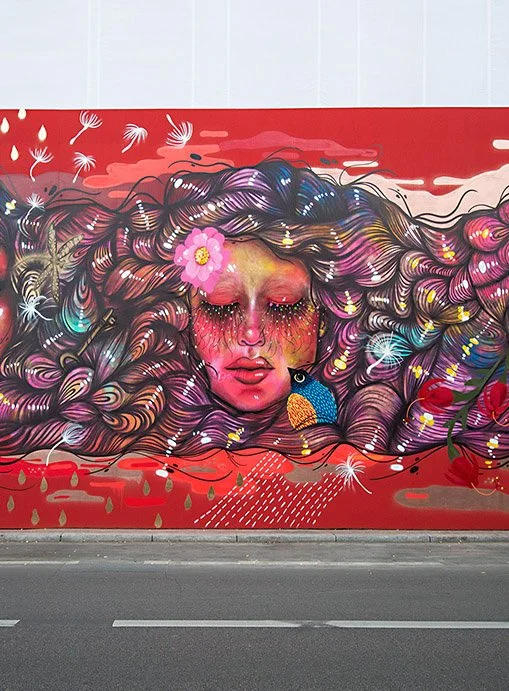What is your biggest inspiration?
I had a very conservative upbringing and that turned me into a very introverted girl, with few friends. When I started to spray, I realized that was a great opportunity for me to relate to other people and since then, my work has always involved the concept of otherness. I build my whole life around the relationships I establish with others. And that is my source of inspiration.
How can urban art promote women’s rights?
I have been doing that through the NGO I founded, the NAMI network, that offers programs and tools for women to learn how to express themselves using the walls. The usage of public spaces is free, you can communicate with everyone, regardless of their race, sex, social class or religion. The projects are thought in a way that the art is not the end, but a means of reaching out to people. We teach so much more than just using the spray paint.
What were the di culties you faced at the beginning of your career?
Lack of money. In the beginning, I used to buy supplies with the money I made teaching art. I didn’t use to go to parties, buy clothes or anything. There was no representativeness back then, so I did not have any female artist as a reference and being successful in graffiti seemed to be impossible, in a world dominated by men. I had to fight three times as hard to gain the same respect and recognition any guy could easily get. And I’m still fighting.
How do you evaluate your work so far?
My work is alive, constantly being changed according to my experiences. I am a political and activist artist and the first step towards any kind of research is to understand that other people have their own experiences and, based on them, I must interpret my body of work. It is all about exchanging things, and I have to see my work through my audience’s eyes, respecting their freedom without imposing my truth.
What is your creative process like?
Since the first idea, it can take years for a project to be completed. From research and lots of experimenting, it can be shaped, reconstructed, transformed or it can die, abandoned.
Why is it important to use different formats to express yourself artistically?
I used to paint many walls around the world and, suddenly, I realized I was more interested in going around the city looking for new places, and in all that used to happen because of my interventions, than the result I used to leave on the wall. It was through performances that I could present these experiences and other types of expression followed, such as installations, photography, videos and objects
What is your favorite work of art?
There are two. The first is the performance Vagina Dentada (Toothed Vagina), in collaboration with artist Caligrapixo, from Sao Paulo, where I recite the homonymous poem as he writes it on my back using a scalpel. The second one is Caminhar (Walking), created from my research on feminicide, where I walk around wearing a white dress with the train dipped in red paint, leaving a trail on the path. I want to take this performance to other cities, leaving a trail of memories about death and mistreatment of women.
Is art a form of resistance to you?
Art has always been a way for me to share my experiences with others, but due to the current situation in Rio de Janeiro, and in Brazil, it will certainly become resistance.
How does technology influence your art?
I don’t have any record of my first works. I am talking about a time when developing a roll of film was expensive and there were no digital cameras. Now, I create something and everybody knows about it. I like to encourage people to participate in my creations. We launched an online campaign to raise money to buy fabric for a dress. Everybody followed the process and that made people contribute more. In the end, everybody could try the dress on, since it was on display at Museu da República, in Rio de Janeiro. I use technology to make my work even more accessible and to create a sense of belonging.
What is the most special place you’ve sprayed?
I have already sprayed in Africa, in the Americas, Europe and Asia, but the dearest place is near my house, on Lavradio Street, in Lapa, Rio de Janeiro.
